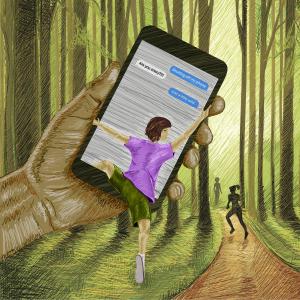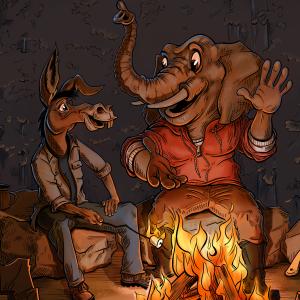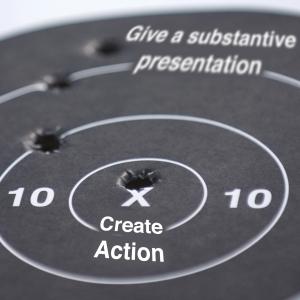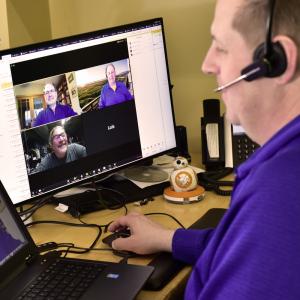How to apply social science to a human dimensions problem
The habitat and wildlife dimensions of conservation issues are generally straightforward. Conservationists know a lot, for example, about how to manipulate habitat to make more deer or ducks or fish.
But knowing how to deal with the human dimensions of conservation issues — that can be much more challenging. Social science helps to understand these human dimensions issues, explain how they work, and make interventions in them when appropriate.
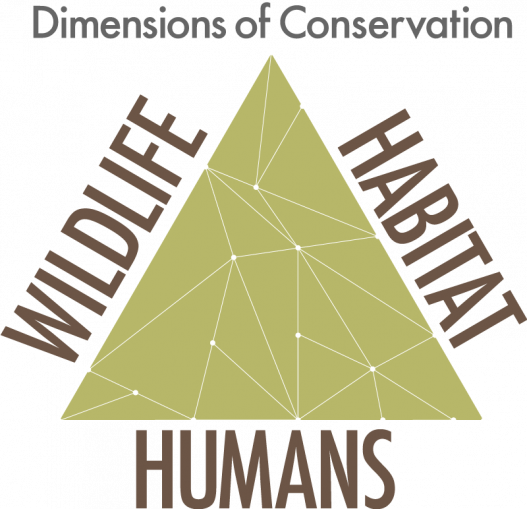
The Basic Social Science Process
The basic social science process has four major steps:
- Measure
- Explain
- Leverage
- Evaluate
Many researchers stop after the first or second step. The partners we serve rarely just want to calculate facts or explain them. They also want to know how to change the human dimensions of conservation to better meet their objectives and trust responsibilities. That's where steps 3 and 4 come in.
1. Measure
We focus on some phenomenon, then measure its extent.
Phenomena can be internal, such as attitudes, values, beliefs, knowledge, and trust. Or they can be external, such as participation rates in an activity, visits to a park, purchases of licenses, or land conversions of wetlands to housing tracts.
2. Explain
Most often, we want to know why a phenomenon is the way it is. Sometimes, it is also useful to look at how a phenomenon came to be. To do so, we focus on identifying social mechanisms. Mechanisms are the “because” portion of the statement: “X caused Y because…”
Mechanisms themselves are generally simple. What is difficult is discerning which ones are at work and measuring them.
Mechanisms are not general laws of human behavior. A mechanism is an explanation of how some feature of the social world produces a future state in the social world. Different features move together to produce an outcome. Mechanisms use less complex, “lower” units of analysis to explain what is happening “above” it. Mechanisms can be drawn from diverse fields: psychology, sociology, economics, anthropology, or political science.
For example, the number of people doing an act signals the value or necessity of that act, which influences other individuals’ choice of action. People visit wildlife refuges that they see other people visiting (bandwagon effect). A group of people stop quail hunting in an area because another group didn’t flush any quail on the last five trips (self-fulfilling prophecy).
3. Leverage
By identifying mechanisms, we can come up with a range of interventions. We can strategically leverage these interventions to make a change—recognizing, of course, there are no guarantees for one particular outcome.
For example, we might find out in measuring that certain ethnoracial groups think of the “family” as including aunts and uncles and cousins. As a result, we might recommend that programs targeting those groups be explicit that “Family Day” means more than parents and their children are welcome.
Levers can be direct or indirect. It is entirely possible to persuade ranchers to do something that helps fish while never mentioning fish. It is also entirely possible to build support for habitat preservation while never mentioning habitat preservation.
Interventions may include marketing. Marketing is important, and is an art and science unto itself. But it is only one lever to pull. Even a clever marketing plan can flounder because of simple oversights: the target audience may lack transportation to reach a destination, or lack time to take a vacation.
Interventions may also include providing information to a target audience. In our experience, this is only one part of a broader suite of actions needed to reach an outcome.
4. Evaluate
We have measured something, explained it, and tried to alter it by leveraging mechanisms. Now we need to evaluate it.
- Did we measure the right thing?
- Did we ask the right questions and ask them in the right way?
- Was the theory we were using useful?
- Do other things interfere with the mechanism(s) we identified?
- Did the leverage points work, or is a new strategy needed?
Examples of the Social Science Process
Here are hypothetical examples of the social science process at work.
Example 1
| Measure | Did this person go hunting today? Yes. |
|---|---|
| Explain | Why did she do so? Because a friend invited her. |
| Leverage | What can we do to get that person to go hunting again? Encourage friends to invite others to go hunting. |
| Evaluate | Did we measure the right thing? Was our explanation accurate? Did we leverage the most useful aspects? Upon closer inspection, the friend’s invitation was important. Also important was the fact that the hunter has been thinking of how to be more self-sufficient for her sources of food. The next iteration of the social science process could examine ties between hunting and the locavore movement. |
Example 2
Occasionally, our partners are interested in what one particular person does. For example, they might care deeply about what the largest landowner in Texas does (since that person owns so much potential waterfowl habitat). Or they might be particularly interested in how the chair of a legislative committee will vote.
Usually, though, conservationists are thinking about larger because the habitat and species they are trying to protect influence — and are influenced by — dozens, hundreds, thousands, or millions of people. Conservationists also have limited budgets, so targeting one person is not cost-effective.
| Measure | How much do landowners support the re-introduction of wolves? One in five support it; the rest are opposed. |
|---|---|
| Explain | Why is support so low? Most landowners do not trust the agency because they generally distrust the government. |
| Leverage | How can we boost support? Research landowners’ reasons for distrust. As a result, promote ways that the agency is fiscally responsible and operates on a limited budget. |
| Evaluate | Were we on the mark? While conducting the promotion, we learn that landowners’ attitudes toward wolves actually have little to do with distrusting the government. Instead, affected landowners felt agency employees were being condescending and were ignoring their input. A new process of discovery begins that examines the extent to which landowners feel heard. If most feel like they’re not being heard, the agency could dedicate resources to listening sessions or inviting influential landowners to participate in an advisory group that is not merely symbolic but has actual influence on decisions. |
Example 3
| Measure |
What is the rate of hunting participation? It is increasing in some places but mostly decreasing. |
|---|---|
| Explain | Why is the rate decreasing in some places but actually increasing in others? Explaining the decrease reveals a lack of social support, competition from other leisure activities, and lower perceived need to hunt in the first place. Explaining the increase reveals the presence of social support, a vibrant mentoring program, and easy access to public lands. |
| Leverage | What can we do about it? Instead of requiring hunters to buy a new license, have their license automatically renew annually (require them to opt out, rather than opt in). Set up a network of hunting mentors who can teach skills and make hunting habitual. Link hunting with the back-to-the-land or locavore movements. Invite pre-existing groups to go hunting. |
| Evaluate | How did we do? Follow up with hunters who increased their participation and tease out the efforts that made a difference. Potentially use A/B testing or an experiment to test interventions. |
Example 4
| Measure |
How fast are prairie potholes being converted to farmland? 100,000 acres per year. |
|---|---|
| Explain | Why are they being converted? Economic incentives (price of soybeans is higher this year than last). Stigma around discussions of estate planning (what happens after farmers pass away). The value of prairie potholes is not well understood. Lack of zoning laws near urban areas. |
| Leverage | What can we do about it? Widely publicize in select areas those who have made commitments to set aside their land, leveraging altruistic enforcement. Begin to create a new social norm that it is good to discuss land ownership well before the owner passes away. Provide information about the benefits of prairie potholes to waterfowl and to humans. Champion for regulatory change in zoning laws. |
| Evaluate | What went well, what didn’t? Publicizing those who have made commitments to set aside their land seemed too much like bragging to local landowners. Instead, a more general announcement that “3% of the land in this county was protected for waterfowl last year” seemed more appropriate. |
Stepping Back
People live breathtakingly diverse lives, including the ways they think about, value, and interact with nature. For some, connection to the natural world is the central feature of their identity. For others, the natural world is somewhere remote and far away. Some primarily interact with the natural world through hunting and fishing. Others have never done it once — even though they visit the great outdoors every weekend.
Conservationists increasingly recognize how important the human dimensions of issues are. A social science process provides a clear, reproducible way to understand these issues and to work toward addressing them. It is a crucial way to discover facts, design interventions, and engage with the public.


